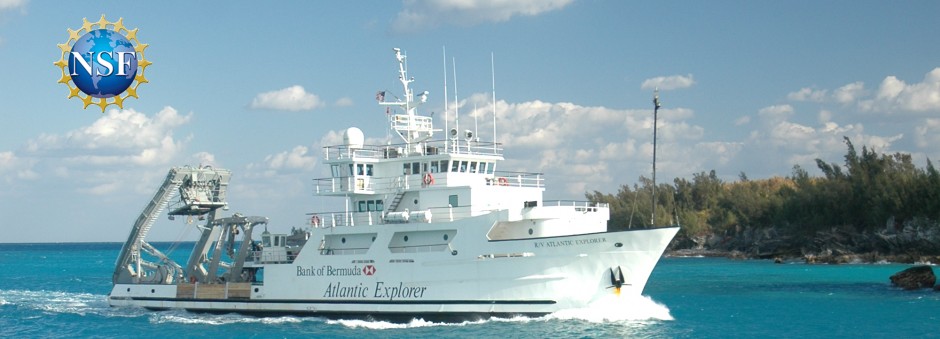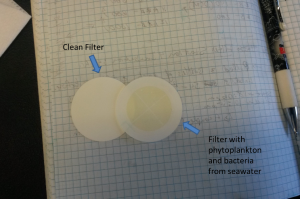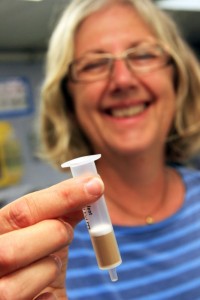The ocean is a very deep place and many interesting things happen in the ocean as you go deeper and deeper. Many of the scientists are interested in examining the chemistry and the microbiology of what lives in the deeper parts of the ocean. It can be very difficult to collect water from very deep parts of the ocean. We use a CTD to collect water at various depths of the ocean. CTD stands for conductivity, temperature and depth (some of the sensors that it contains). The CTD also has many bottles that can be used to collect water. We can lower the CTD into the water and trigger these bottles to close at different depths sealing the water in the bottle. Upon returning to the deck we can collect the water and use it for different purposes.

Sam preparing the CTD for deployment
For example, many of the microbiologists are interested in collecting the bacteria and phytoplankton that live in the water. To do this we will filter water so that it will trap most of the microbes on the filter. This allows us to concentrate the bacteria on the filter and take them back to lab for further investigation.
Barbara is interested in studying how carbon-containing compounds are different in the deep ocean. To do this she can collect these compounds using special columns designed to trap all of these carbon-containing compounds. Sam and Violetta are also looking at how different chemicals change at different depths over long periods of time. All of this together will help us to better understand our oceans and how humans impact them.
-Molly Redmond, Stephen Techtmann, and Steve Tuorto






This sounds like a great experience, Stephen! Hope you’re doing well! That seawater filtration system looks pretty neat, how does it work?
Does increasing ocean acidity affect deep sea creatures the same way it does to shallow water creatures?
steven tuorto ctd sampling seems really cool but how does it work?
The CTD is really just a very complicated way of opening and closing bottles. The bottles on the CTD start out open. Marine technicians help the scientists send the CTD over the side of the ship. Then scientist work together with the ships crew to lower to the CTD to however deep we want to go. On this we had one CTD go down to 5000 meters… thats over 3 miles down!! Then we begin to bring the CDT back up and when we get to a depth that we want a sample from, we stop the CTD and flip a switch that closes the bottles. When the CTD is back on board, we use spouts to collect the water. The CTD also has many complicated instruments on it that tells us the temperature, how salty the water is, and how much chlorophyll is in the water. It is a very cool instrument to work with!
Watch a video of a CTD at work HERE.
Thanks,
Steve Tuorto
This is a question for Stephen Techtmann, Molly Redmond, Steve Tuorto
What have you learned so far about the chemistry and microbiology of what lives in the deep oceans?
Hi Olivia,
Much of the bacteria in the deep oceans are very similar to the bacteria that are in the surface ocean and on land. But because the deep ocean is what we call an “extreme environment” (because it is very cold, very dark, and their is a lot of pressure), we are also discovering bacteria that do things in very different way. For instance, many bacteria live off of the chemicals that come out of undersea volcanoes. Very cool!
Thanks,
Steve Tuorto
this is cool and what is the water like at woods hole is this water clean or dirty and what kind of chemicals are there
Sounds like fun! Does the depth and the viscosity of salt ever change? If it does would there ever be new types of fish?